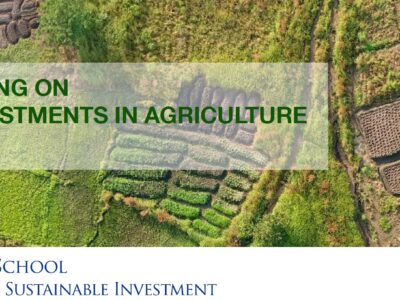By Sara Barbour
Mama Churi knows how valuable nature can be. A Tanzanian mother, wife and farmer who grows rice, raises fish and tends beehives, she is straightforward about the fact that while her husband’s job as a teacher provides some reliable income, her nature-dependent activities provide as much money to their family as he does—or more.
But Mama Churi is finding that unpredictable rain patterns are threatening her income and her way of life. Temperatures and rainfall patterns have become increasingly erratic in Tanzania, and for farmers who depend on a reliable rainy season to know when to plant, this has huge implications for their ability to feed their families and earn a steady living.
Enter Tanzania’s Agriculture Climate Resilience Plan, developed by the Ministry of Agriculture, Food Security and Cooperatives. This ambitious action plan, which outlines the risks of climate change to agricultural growth in Tanzania, presents a strategy for sustainable agricultural development in the face of shifting rainfall patterns and other effects of a changing climate.
With a population set to triple by 2050 and 75–80 percent of Tanzanians earning their livelihood through smallholder agriculture, the stakes are high.
The plan includes four priority actions for increasing resilience:
- Improve agricultural water and land management;
- Accelerate uptake of climate-smart agriculture;
- Reduce impacts of climate-related shocks through improved risk management; and
- Strengthen knowledge and systems to target climate action.
A critical part of implementing this strategy is measuring and tracking these priority actions. Vital Signs, a monitoring system that tracks agriculture, ecosystems and human well-being, is partnering with Tanzania to help ensure the plan accomplishes its goals. Vital Signs is led by Conservation International in partnership with the Agriculture and Food Security Center at the Earth Institute and the Council for Scientific and Industrial Research in South Africa. Cheryl Palm of the Agriculture and Food Security Center is the deputy director and on the Technical Council; several center staff also work on the project.
Vital Signs measures resilience: the ability of people, crops and ecosystems to stay healthy and productive in the face of various threats. The system collects data that feeds into indicators like resilience of agriculture, resilience of ecosystems, and resilience of income. Through monitoring precipitation, temperature, yield, ecosystem services and more, Vital Signs tracks abrupt changes to provide advance warning of tipping points.
For example, to help leaders in the Ministry of Agriculture, Food Security and Cooperatives track the success of their priority action to improve water management, Vital Signs has created a visualization of water availability in Tanzania’s Southern Agricultural Growth Corridor. In addition to our team collecting new water data, Vital Signs has mobilized existing data to help policymakers track water levels and flow.
Recently in Addis Ababa, Ethiopia, Vital Signs and the Tanzanian ministry co-hosted an event at the African Green Revolution Forum to present their partnership to address climate resilient agriculture as a model for other African countries. At the event, the ministry introduced the Agriculture Climate Resilience Plan, and Vital Signs will share data and indicators of resilience that will support its implementation.
With field teams collecting data in Tanzania and Ghana since mid-2013, and plans for scaling up to 10 countries in Africa, Vital Signs has proven a vital tool for Conservation International and its partners in collaborating and partnering with African governments, other NGOs, the private sector and key international partners in guiding agricultural development that is sustainable for people and nature.
Sara Barbour is Conservation International’s senior coordinator for Vital Signs. Launched with a grant from the Bill & Melinda Gates Foundation, Vital Signs is led by Conservation International in partnership with the Earth Institute, Columbia University and the Council for Scientific and Industrial Research in South Africa. This story was first posted on Conservation International’s blog, Human Nature.



